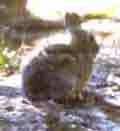|
|
||
 |
||
|
|
||
Pikas,
Rabbits and Hares
Legendary for their ability to reproduce,
members of the order Lagomorpha are found on every continent. The order includes
two families: Ochotonidae, the Pikas, and Leporidae, the rabbits and hares.
Based on outward appearances you might think that
rodents and lagomorphs are closely related. They do have a similar appearance,
they exist in similar ecological niches![]() , they are vegetarian,
and they have continuously growing incisors, but they are fundamentally different.
Mammalogists now think that lagomorphs are more closely related to ungulates
(the hoofed mammals) than to rodents.
, they are vegetarian,
and they have continuously growing incisors, but they are fundamentally different.
Mammalogists now think that lagomorphs are more closely related to ungulates
(the hoofed mammals) than to rodents.
Their continuously growing incisors are well suited
for gnawing and nipping vegetation. This continuous growth is an adaptation
to the abrasiveness of their food and helps maintain a chisel edge on the
incisors. Lagomorphs have two upper incisors on each side, while rodents have
only one. The second one is a small peg behind the large incisor in front.
An interesting behavior of lagomorphs is ingestion
of their own feces (coprophagy![]() ). They defecate two types
of feces, the dry, oval pellets that we commonly find in their habitat, and
a black, viscous dropping that they promptly eat. It is thought that this
practice reserves certain vitamins and other nutrients for them.
). They defecate two types
of feces, the dry, oval pellets that we commonly find in their habitat, and
a black, viscous dropping that they promptly eat. It is thought that this
practice reserves certain vitamins and other nutrients for them.
Rabbit young are born naked and rather helpless (altricial![]() ). Hares bear young that
are furred and able to move about shortly after birth (precocial
). Hares bear young that
are furred and able to move about shortly after birth (precocial![]() ). In Idaho there are six
species present from this order.
). In Idaho there are six
species present from this order.
Ochotonidae - Pikas
There are only two species of pikas in North America,
only one is found in Idaho. Pikas are quite different in appearance from rabbits
and hares. They are similar in size and shape to a guinea pig. They are no
more than ½ pound in weight, they have no noticeable tail, and they have small
hind feet with all four feet having fur on the soles. This provides them with
good traction for scurrying about in the rocks of talus slopes, their primary
habitat. Unlike rabbits and hares, they are active during the day, and they
store food and are very social and vocal.
Leporidae - Rabbits and Hares
Rabbits and hares are larger than pikas,
have long ears and hind feet, and can run and hop very rapidly to escape predators.
Unlike pikas they are not typically found in rocky, talus![]() , mountain slopes. Rabbits
and hares have noticeable tails, especially "cottontail" rabbits. Rabbits
give birth to very immature young, termed "altricial
, mountain slopes. Rabbits
and hares have noticeable tails, especially "cottontail" rabbits. Rabbits
give birth to very immature young, termed "altricial![]() " young. They are born
without hare, their eyes are closed at birth, and they stay concealed in the
natal
" young. They are born
without hare, their eyes are closed at birth, and they stay concealed in the
natal![]() nest while the mother
nurses them. Hares give birth to young that are much more developed, or "precocial
nest while the mother
nurses them. Hares give birth to young that are much more developed, or "precocial![]() " young. They are born
with hair, their eyes are open and they are able to move about shortly after
birth. Hares do not dig or utilize burrows while rabbits do.
" young. They are born
with hair, their eyes are open and they are able to move about shortly after
birth. Hares do not dig or utilize burrows while rabbits do.